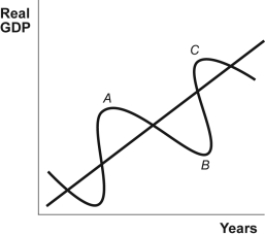A) inflation.
B) monopolies.
C) spillovers, such as pollution.
D) mergers.
Correct Answer

verified
Correct Answer
verified
Multiple Choice
The alternation between recessions and expansions is known as the:
A) unemployment rate.
B) long-run economic growth.
C) business cycle.
D) macroeconomy.
Correct Answer

verified
Correct Answer
verified
Multiple Choice
Keynesian economics stressed:
A) the importance of total spending.
B) the self-correcting power of free markets.
C) the long run.
D) that the Depression should run its course to bring down the high cost of living.
Correct Answer

verified
Correct Answer
verified
Multiple Choice
Use the following to answer questions:
Figure: The Business Cycle  -(Figure: The Business Cycle) Look at the figure The Business Cycle. Point B on this graph shows a(n) :
-(Figure: The Business Cycle) Look at the figure The Business Cycle. Point B on this graph shows a(n) :
A) peak.
B) trough.
C) expansion.
D) recession.
Correct Answer

verified
Correct Answer
verified
Multiple Choice
When overall price levels rise over time, it is referred to as:
A) deflation.
B) inflation.
C) an increase in purchasing power.
D) the consumer price index.
Correct Answer

verified
Correct Answer
verified
Multiple Choice
"Macroeconomics is nothing but a simple aggregation of all the microeconomic parts." Do you agree or disagree with this statement?
A) Don't agree; there is a lot more to the study of macroeconomics than the sum of its microeconomic parts.
B) Agree; macroeconomics is exactly equal to the total of all microeconomic units.
C) Don't agree; these two disciplines deal with completely independent issues.
D) Don't agree; microeconomics is an aggregation of all the macroeconomic parts.
Correct Answer

verified
Correct Answer
verified
Multiple Choice
Which one of the following measures long-run economic growth?
A) a rise in employment
B) an increase in the money supply
C) a sustained increase in the production of goods and services
D) an increase in the labor force
Correct Answer

verified
Correct Answer
verified
Multiple Choice
A recession leads to all of the following EXCEPT:
A) higher unemployment.
B) reduced output.
C) reduced income and living standards.
D) higher employment.
Correct Answer

verified
Correct Answer
verified
Multiple Choice
During the Great Depression, unemployment rates reached as high as:
A) 25%.
B) 50%.
C) 10%.
D) 60%.
Correct Answer

verified
Correct Answer
verified
Multiple Choice
The most painful consequence of a recession is:
A) rising unemployment.
B) increasing inflation.
C) increasing aggregate output.
D) higher interest rates.
Correct Answer

verified
Correct Answer
verified
Multiple Choice
When an economy is operating between a trough and a peak of the business cycle, it is in:
A) an expansion.
B) a contraction.
C) a short-run condition.
D) the beginning of a fall in aggregate spending.
Correct Answer

verified
Correct Answer
verified
Multiple Choice
An economic recovery encompasses all of the following EXCEPT:
A) sustained economic growth.
B) a short-run increase in aggregate production.
C) a time of increasing employment.
D) the end of the business cycle.
Correct Answer

verified
Correct Answer
verified
True/False
Following a trough, real GDP increases.
Correct Answer

verified
Correct Answer
verified
True/False
Recessions are periods in which output and employment are falling.
Correct Answer

verified
Correct Answer
verified
Multiple Choice
In macroeconomics:
A) aggregate data such as real GDP, the price level, and unemployment are analyzed.
B) individual and firm decisions regarding utility and profit maximization are studied.
C) long-term growth is not considered to be important.
D) market intervention from the government is not considered important.
Correct Answer

verified
Correct Answer
verified
True/False
The business cycle is the long-run alternation between downturns and upturns.
Correct Answer

verified
Correct Answer
verified
Multiple Choice
Inflation:
A) raises the cost of making purchases.
B) can result in a decrease in barter transactions.
C) encourages people to hold cash.
D) is caused by changes in interest rates.
Correct Answer

verified
Correct Answer
verified
Multiple Choice
An open economy:
A) trades only with its neighbors.
B) trades goods but not services or assets with other countries.
C) does not trade goods, services, or assets with other countries.
D) trades goods and services with other countries.
Correct Answer

verified
Correct Answer
verified
Multiple Choice
The topics studied in macroeconomics include:
A) inflation.
B) unemployment.
C) economic growth.
D) inflation, unemployment, and economic growth.
Correct Answer

verified
Correct Answer
verified
Multiple Choice
An open economy:
A) trades goods and services with other countries.
B) does not regulate its industries.
C) does not impose taxes on its citizens.
D) allows free practice of speech and religion.
Correct Answer

verified
Correct Answer
verified
Showing 81 - 100 of 168
Related Exams